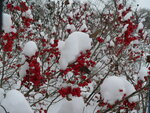



The days are getting shorter and it’s almost time to wrap up the gardening season. When planning garden spaces, we often think about staggering bloom times so we can enjoy beautiful flowers from early spring to late fall – and we assume that the garden will inevitably be bare and boring all winter. However, there are a number of plants that grow well in our northern climate that become even lovelier when the temperatures drop. Read on for tips on choosing plants for winter interest in your yard and garden!
Essentially, there are three main ways to add outdoor interest during winter months: by using colors, textures, or structures to break up the monotonous landscape. Evergreen shrubs and trees, plants with colorful berries, plants with interesting bark or stem colors, and plants with interesting shapes can all fit the bill. To maximize winter interest, consider the view when you look out the window. Make sure your most exciting winter plants will be visible from indoors so you can enjoy them even during freezing temperatures.
There are many large evergreen trees, but in our south Minneapolis yards, smaller varieties are usually the way to go. “Sea Green” is a small juniper variety that features bright green foliage year-round and has an upright growth pattern with distinctive arching branches. There are also several smaller varieties of yew, such as Taunton spreading yew or Japanese dwarf yew, which grow slowly and will stay green all year. Finally, boxwood shrubs are a good evergreen choice and can be used in hedges (or sheared into topiary shapes if you are ambitious).
Plants with berries that persist throughout the winter are another good choice, both to add color and to provide a food source for wildlife. Winterberry is a popular shrub that loses its leaves in the fall but keeps its striking red berries for several months. Be sure to plant both a male and female winterberry plant so fruit can be produced. Smaller varieties to look for include Goldfinch (female), Red Sprite (female), and Jim Dandy (male). Viburnum is another excellent choice for year-round interest, featuring flowers in the summer and berries in the winter. The viburnum variety called American high-bush cranberry (also known as American cranberrybush) is a large shrub that produces clusters of white flowers in June and then round red fruits in August and September. The fruits are edible to humans and wildlife and are similar to cranberries, although they are not technically related.
Unusual bark and stem colors or shapes can also contribute to an interesting winter landscape. One great option is dogwood, which has striking red stems. Try cutting a few dogwood branches and placing them in a pot to create an outdoor decorative arrangement that will look great all winter. River birch, with its white bark, also looks beautiful throughout the winter. Some varieties of river birch are very large, but Fox Valley and Summer Cascade are two smaller options, reaching a mature height of 8-10 feet. You could also consider the corkscrew willow, which features wavy, twisted branches that lend an interesting texture to the winter landscape and can be shaped as a tree or large shrub. The main drawback to corkscrew willows is that they are relatively short-lived compared to other trees, generally lasting 15 to 20 years.
No matter what plants you have in your yard, you can add winter interest by leaving stems and flowers intact rather than cutting them down in the fall. Seed heads, grasses, pinecones, and other organic material can provide texture to the landscape and also serve as a source of food and shelter for overwintering birds. Black-eyed Susan, little bluestem, and switchgrass are popular perennials for winter interest. In the spring, wait until April or even May to clear garden debris, to ensure that any hiding pollinators are protected until the weather warms up.
For more information, check out the University of Minnesota Extension Yard and Garden website. Extension resources are written by experts, and contain the latest and most reliable research-based information. Happy gardening!
Comments
No comments on this item Please log in to comment by clicking here